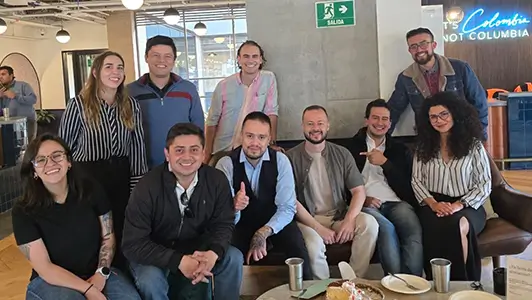Revolution or evolution?
“Viva La Revolución!” seems to be the battle cry when a new transformative technology arrives and promises, or threatens, to change our lives. Whether it be the wheel, the Industrial Revolution, the introduction of the cloud, or most recently, generative AI, with the next surely to be named later -“Rise of the Machines,” perhaps? While, at first, these events look like revolutionary changes in society, a closer look reveals that each of these is the result of evolutionary changes over time shaped by creative efforts. In the spirit of embracing change-enabling creativity, we will explore generative AI, its governance, and how governance should be leveraged to promote evolutionary creativity vs. traditional permission-based approaches.
Returning to our evolutionary change concept, the Industrial Revolution started in Great Britain roughly in the 1760s. However, the first commercially viable steam engine was developed around 1712. In the fifty years leading up to the 1760s, many different advancements culminated in what is historically known as the Industrial Revolution. The technologies that are foundational for generative AI have been evolving and developing since Alan Turing’s seminal 1950 paper entitled “Computing Machinery and Intelligence” and the creation of Frank Rosenblatt’s “Perceptron” in 1957, which was an early form of neural network. These “revolutionary” occurrences can really be seen as the point where the movement has reached the scale to transcend any one purpose and become multi-purpose. Generative AI is no different.
Constraints drive creativity
The common thread that enabled these initial ideas to evolve into something transformative was the ability to apply creative effort and power to ideas to see how they might be used beyond their original purpose. For example, the “Perceptron” was initially designed to mimic the human brain but established a pattern used to drive deep learning models today to answer or predict any number of questions across multiple industries. The same can be said for activities within a company or organization. Every day, we face different problems that can require us to “get the creative juices flowing” or simply follow best practices, and it is incumbent on each of us to determine where to apply the right energy. However, these creative juices, left unchecked, can drive unwelcome outcomes. Enter governance – an organization’s approach to applying controls to this creative process.
Governance has often been viewed as an overly restrictive yet required practice to manage data, behaviors, and access as the potential for legal, social, or environmental ramifications grows. It has often been viewed as a group or entity that blesses and grants permission to condone different behaviors or access to data and processes, all to accomplish business goals and drive additional standardization and value. As generative AI continues to grow in applicability in our environments, we all need to rethink our views of governance and shift how enforcement occurs to unlock the full creative potential of employees to explore, discover, and achieve truly novel results. This requires a mindset shift, looking at governance as a way of establishing constraints intended to shape outcomes vs. purely granting permissions.
Constraints establish boundaries, not restrictions. They establish a “safe” space to experiment or try new things without violating security standards or data access controls. They don’t increase the overall size of the attack surface or open the organization to additional risk.
Thesis: As we all travel on the journey to unlocking the value of generative AI, we should view governance as an engine for creativity, understand how ready our organization is to adopt a creative generative AI policy successfully, differentiate how AI governance might look different than traditional governance, and how to implement AI governance in a way that drives outcomes that unlocks the creativity of our teams.
Governance as a creativity enabler
The key to thinking about governance is to leverage its constructs to shape pathways for creativity to flow. Rather than addressing governance through the lens of what is and isn’t allowed, it should be approached through what guardrails are required to enable progress while meeting business needs. Water flowing along a defined path unhindered creates tremendous energy that can be harnessed. When that flow is disrupted, the energy that can be harnessed drops considerably. Equally, continuous flow enables evolution, whereas constants hindrances demand transformation, a far lengthier and riskier approach to change.
The domain is vast, but there are typically a handful of core tenets that comprise technology-oriented governance. For this article’s purpose, we’ll focus on the following:
- Business strategy alignment
- Risk management
- Compliance and regulatory adherence
- Resource management
- Performance measurement
- Stakeholder engagement
- Security and privacy
- Ethical considerations
- Continuous improvement
- Transparency and accountability
The intent isn’t to offer a detailed explanation of what these ten governance tenets mean for generative AI but rather to offer pointed guidance on how to approach them to enable creativity. Incorporating generative AI into a technology governance framework that enables creativity involves reshaping each tenet to address the opportunities and challenges that generative AI presents. Here’s how the core tenets should be adapted to foster innovation and creativity using generative AI (these are not ranked in order of importance):
Alignment with business strategy
Governance should facilitate using generative AI to explore new strategic avenues and innovate within existing ones. By defining strategic goals that include generative AI initiatives, organizations can unlock novel approaches to achieving their objectives, encouraging teams to think creatively about leveraging AI for competitive advantage. In other words – embrace generative AI.
Risk management
Adopting generative AI introduces unique risks, including ethical considerations and data biases. Governance frameworks should define acceptable risk thresholds for AI projects, enabling teams to experiment with generative AI within safe bounds. This approach encourages responsible innovation, balancing AI’s potential with the need to mitigate its risks. Leverage well-defined risk matrices to guide teams toward self-manageable acceptable risk thresholds.
Compliance and regulatory adherence
Regulations around AI are evolving. Governance should proactively address these changes by incorporating compliance into the creative process. By understanding and anticipating regulatory requirements, teams can use generative AI to innovate in ways that are compliant and set new standards for responsible AI use. Education and constant information flow are critical to limiting the compliance tollgates.
Resource management
Accessing the necessary datasets, computing power, and AI tools can significantly boost AI-driven innovation. Governance should ensure that resources are allocated in a way that supports exploration and creativity with generative AI, enabling teams to push the boundaries of what’s possible. Establish well-defined resource constraints upfront and ensure teams understand where limitations should focus the creative energy.
Performance measurement
Metrics for evaluating the success of generative AI initiatives should include measures of innovation, efficiency gains, and the ability to generate new insights or products. By recognizing and rewarding creative achievements enabled by AI, organizations can cultivate an environment where innovative thinking thrives. Start with the question: who should be able to do WHAT better and more efficiently?
Stakeholder engagement
Incorporating stakeholder feedback into the development and deployment of generative AI projects can spark creative solutions to complex problems. Governance should facilitate engagement processes that gather diverse insights, ensuring AI applications are innovative and aligned with stakeholder needs. Feedback loops are critical to steering the creative flow.
Security and privacy
When deploying generative AI, governance must define clear security and privacy guidelines to protect data and outputs. Organizations can foster innovation while maintaining trust by establishing creative approaches to security, such as using AI to enhance data protection methods. Look to automation and enterprise policies to build the sandbox where projects can operate more freely.
Ethical considerations
Governance should outline ethical principles for using generative AI, encouraging teams to consider the broader impacts of their work. By fostering an ethical approach to AI development, organizations can inspire creative solutions that are both technologically advanced and socially responsible. Education and ever-evolving ethical standards are key.
Continuous improvement
Governance frameworks should emphasize the iterative nature of AI development and support ongoing learning and adaptation. Encouraging teams to refine and evolve their AI models continually can lead to breakthrough innovations and creative applications that keep the organization at the forefront of technology. Define clear and well-understood success measures.
Transparency and accountability
Transparency in how AI models are developed, trained, and deployed encourages a culture of accountability and innovation. Governance should ensure processes are in place for documenting and sharing AI development practices, enabling creative collaboration and learning from successes and setbacks. Celebrate transparency.
Adapting governance to foster creativity with generative AI involves recognizing the technology’s potential to improve industries and society significantly. Organizations can leverage generative AI to drive growth, enhance decision-making, and create novel solutions to complex challenges by crafting governance frameworks that encourage responsible exploration and innovation.
Conclusion
It is said that the only constant is change. And the perceived rate of change is often driven by where you mark your starting and ending points in time. Are we living through an AI revolution, or are we somewhere in the lengthy gradient where generative AI catalyzes evolutionary change? We believe this change is evolutionary and continues to present meaningful promise in unlocking the creative potential of many.
In this vein, generative AI presents a unique opportunity for organizations to drive growth, enhance decision-making, and create novel solutions to complex challenges. Yet, with great power comes great responsibility, so governance must play a role in generative AI adoption. To fully unlock generative AI’s potential, a shift in mindset is required, where governance is viewed as an engine for creativity rather than a permissions-based restrictive practice.
By adapting governance frameworks to encourage responsible exploration and innovation, organizations can leverage generative AI to its fullest potential. Governance should be approached by establishing constraints intended to shape outcomes rather than purely granting permissions. By doing so, organizations can unlock the full creative potential of their employees and achieve truly impactful results.





















